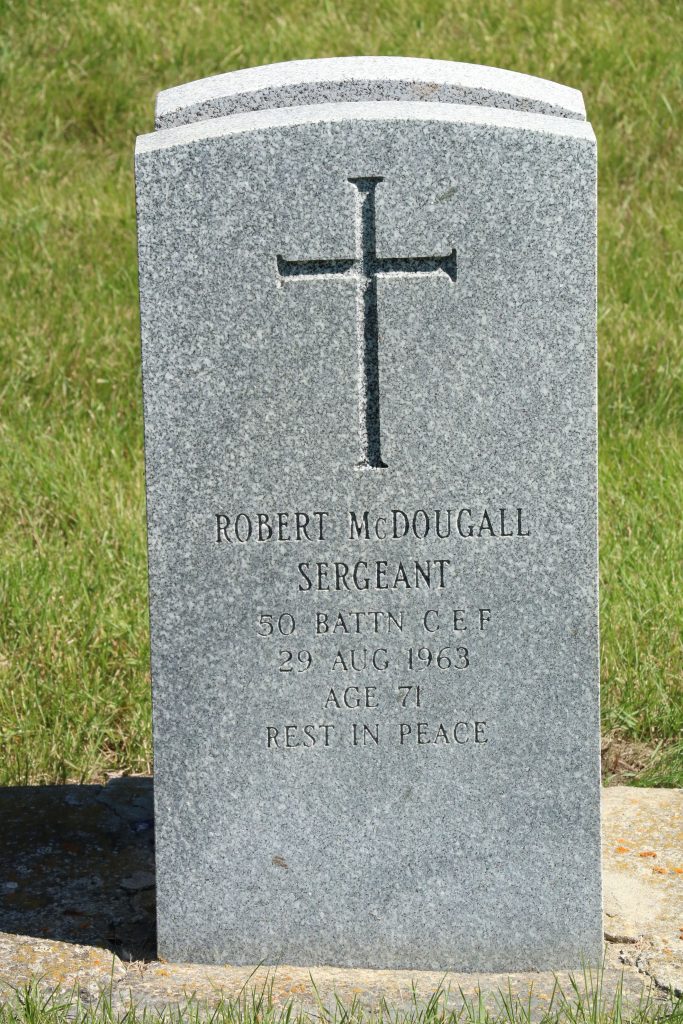Great War Dundee
This is Dundee's story of those that served in the First World War, and of the people left at home
Robert McDougall
Military Information
- Date of enlistment: 31.12.1914
- Place of enlistment: Calgary, Alberta, Canada
- Service no: 434140
- Rank: Sergeant
- Service Occupation:
- Awards: Military Medal & Bar
- Regiment/Service: Canadian Infantry
- Unit/Ship: 50th Battalion
Personal Information
- Date of Birth: 12.09.1891
- Place of Birth: Dundee
- Address:
- Occupation: Calgary Postal Service
- Mother:
Margaret Bruce
- Father:
William McDougall, Meigle, Perthshire
- Siblings:
Maggie, Marjory, Eliza & David
- Spouse:
Nellie McDougall (nee Paton)
- Children:
Violet, Douglas & Thelma
- Age at Death: 71
- Date of Death: 29.08.1963
- Place of Death: Calgary, Canada
- Burial Country: Canada
- Cemetery: Burnsland Cemetery, Calgary
More about Robert McDougall
Born at 6 Pole Street, Dundee, on September 12, 1891, Robert was the third of five siblings, preceded by Maggie and Marjory (May) and followed by Eliza and David. Their parents, our great-grandparents, were Wullie McDougall, at that time a ‘lorry driver’ (more a carter in those days), and Margaret Bruce. They never stayed in any one place for very long, going where the work was, usually employed in agriculture.
By the 1901 census, the McDougalls had moved on to Simprin Farm Cottages, roughly between Meigle and Airlie, where Wullie was now breaking horses to the plough. Robert, aged 10, attended school at Airlie. The only other scrap of information left over from his childhood was “extensive scars from burns” on the left side of his chest relating to some bygone treatment for pleurisy.
Marjory was the first of the siblings to emigrate to Canada, at some stage between the 1901 census and the birth of her first child, Bill Fairburn, in Saskatchewan, in 1909. She is the only one missing from the 1911 census back home in Scotland. Among her multiple offspring was ‘Gentleman Jim’ Fairburn, a World Championship-winning ice hockey player.
Robert was next to follow, in 1912, possibly via New York but certainly first arriving in Winnipeg, looking for work as a ‘teamster’ or what we’d call a HGV driver.
Maggie was the final one to flit to the Great White North, from West Scryne Farm, Carnoustie, finding a new home in Toronto with her husband David Nairn and their bairns. More on this branch at a later date.
Eliza moved to Hawick as a nurse probationer at the Anderson Sanatorium, where she’d meet her future husband Neil, our grandfather. David McDougall was the only one to stay put in Angus, as a ploughman with James A. Jarron at Inverkeilor, and latterly he and his wives made a home in Arbroath.
At the outbreak of the First World War, Robert, now in his 20s, was a teamster living in Calgary, Alberta. He enlisted as a private there on Hogmanay 1914, with the 50th Btn. Canadian Expeditionary Force (Calgary Regiment). His forwarding address was the General Post Office. When enlisting for the CEF, Robert was 5ft 10ins, with blue eyes and brown hair, and a Presbyterian – useful intel as we don’t yet have a photo of the man.
While still in training, in June 1915, he suffered from balanitis… which was apparently cured with mercury! Ouch!
His regiment then sailed from Halifax in October 1915 aboard the SS Orduña headed for further training in Britain. Many months down the line, the 50th CEF was moved to France ahead of the brutal Battle of the Somme and the Battle of Ancre Heights – Robert’s first proper taste of war. By December 1916 he had been promoted to lance corporal.
At the Somme, the world’s largest graveyard, there were at least 25,000 Canadian casualties alone.
The regiment moved to Artois in November 1916 where they spent their winter and Christmas preparing for the offensive against Vimy Ridge. If you haven’t had the opportunity to visit the Canadian National Vimy Memorial there, it’s quite honestly perhaps the most poignant and awe-inspiring monument I’ve ever seen.
During the Battle of Vimy Ridge, on April 9-12, 1917, Robert kept a bound field message book in which he recorded the names of those in A, B, C and D Companies, as well as various signals on the battlefield. He included information about “parade and rations state,” and on carefully folded slips of paper detailed battalion codes, diagrams, and lists of equipment.
His notes also contain the names of soldiers and their next of kin, as well as the dates they died, a sober reminder of the realities of war. Especially poignant is a hand-written tribute (see photos) to one of his Company, Corporal Laurence William Kirkland, 21-year-old ‘Kirky’, killed in action on April 12.
The 50th CEF were next assigned to attack Hill 145. After many attempts to capture the promontory, they finally managed to take it from the Bavarian Reserve force. For the next two days, the battalion tried to attack the little knoll known as ‘the Pimple’. Finally, the Bavarians, low on food and having suffered many casualties, surrendered the Pimple and retreated from Vimy. The 50th CEF, having themselves suffered heavy casualties, were taken out of the line and rested for a while.
Preparations began for the Battle of Hill 70. They fought the Germans in the streets of Lens and in the generating plant a group of Germans had fortified. After a hard-fought battle there, the Canadians gained a reputation as elite troops. During this battle, they were taken out of the line for a little bit and placed into billets with French families.
On June 9, 1917, Robert was granted a week’s leave to England. In September 1917, he was given permission to marry Nellie Bett Paton (also known as Betty or Bette), a Scottish exile based in Bowes Park, London, where she remained for the duration of the war. Robert also made a military will which would bequeath any fortunes amassed to his father Wullie in the event he was killed.
Field Marshal Sir Douglas Haig ordered the bulk of the Canadians into the heavy fighting at Liévin and Hill 65 in June and July 1917. In November that year, Robert was appointed Acting Corporal and then Acting Sergeant, all within a few short weeks.
The Canadians were latterly ordered to one of the costliest battles in the war, the Third Battle of Ypres, resulting in 1,600 dead and many more wounded, a quarter of their fighting strength. They did, however, mange to capture the village of Passchendaele.
During the initial stages of the German spring offensive that was launched in early 1918, the 50th CEF, along with the other Canadian units, was taken out of the line to conduct training and, as a result, missed the heaviest part of the fighting.
On April 24, 1918, Robert was awarded the Military Medal “for bravery in battle on land” – to which a Bar was added on November 21, 1918, by which time he’d been up and down the ranks before reaching the permanent position of sergeant. Alternate pages of his military records give different dates for the MM, including February 22, 1918. It also states the news was published in the London Gazette… not true. It was published in the Canada Gazette with scant information about why he received not only the MM but also the Bar (equivalent of a second award).
In the last 100 days of the Great War, the 50th CEF fought at the Battle of Amiens; the Battle of Arras; the Battle of Cambrai, where they helped recapture Cambrai and hold it against German attacks; the Battle of Drocourt-Quéant; the Battle of the Canal du Nord; and the Battle of Valenciennes, one of the last battles of the war, where Mons was recaptured.
In August 1918, Robert was granted two weeks’ leave to visit the UK, likely seeing Nellie. In January 1919 he attended the Central Wireless School to learn new skills, and in March that year was granted extra leave to visit Britain once more. August 28, 1919, is apparently the date on which the Bar was added to his MM.
On being demobbed at Calgary in September 1919, Robert received a war service gratuity and found work as a clerk at the GPO. As an aside, The Calgary Tigers football team was renamed Calgary 50th Battalion for the 1923 and 1924 seasons in the Alberta Rugby Football Union to commemorate the battalion’s wartime actions.
Robert and Nellie’s first child, Violet Margaret McDougall (d.2009) was born at Calgary in 1920. She latterly lived at Three Hills, Kneehill, and was married twice – first to Reginald Stringer, ex-RAF, producing one son, and then to Johnston Hart.
In October 1921, Robert, perhaps missing the structure of military life, enlisted with the 13th Canadian Corps of Signals. By 1924 the family was living at 34A, 34th Avenue South-West, Calgary – in the burgh of Roxboro. This was a nice bit of unintended symmetry as sister Eliza was living in Hawick, County of Roxburgh.
The next child to arrive was Douglas or Doug M. McDougall (d.2017) born at Calgary in 1925. He married Eileen Flodell and they had four children: Heather, Duncan, Janice, and Marshall. Keen Jehovah’s Witnesses, this branch of the McDougalls bid at 32nd Avenue South-West.
The third and final child, Thelma Jean McDougall (d.1964) was born at Calgary in 1926. I haven’t yet uncovered why she only lived to her 30s.
From September 1928, Robert was promoted to Acting Regimental Sergeant-Major following a seal of approval from the Minister of National Defence. In April 1929, he received a further promotion to 1st Class Warrant Officer.
In May 1934, Robert was then awarded the Canadian Efficiency Medal for “completing twenty years of meritorious military service”. Winding down his military career, he transferred the 13th Signals (Reserve) Btn. in January 1936 before relinquishing his warrant and commission when his regiment was disbanded in March of that year.
As far as I can tell, Robert remained with the Calgary Postal Service until retiring in 1951. He died in the city on August 29, 1963, after which a funeral was held in the Little Chapel on the Corner. As mentioned already, he was buried in the Field of Honour, in Burnsland Cemetery, less than 100m across the highway from his family home.
Kneehill Historical Museum would later purchase his field message book and other wartime ephemera left in a trunk by Johnston Hart’s estate, following the death of his son-in-law.
Gary Thomson, additional information kindly supplied by Robert’s great-great nephew, Alastair Redpath
Can you tell us more about Robert McDougall'? Some additional facts, a small story handed down through the family or perhaps a picture or an heirloom you can share online. Contact our curator...

